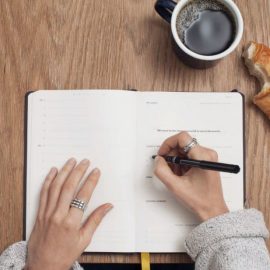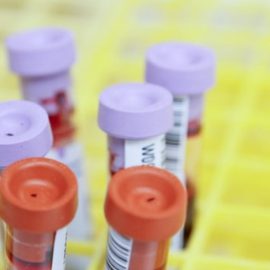

This article is an excerpt from the Shortform book guide to "Girl, Stop Apologizing" by Rachel Hollis. Shortform has the world's best summaries and analyses of books you should be reading.
Like this article? Sign up for a free trial here .
What does the daily routine of a mother look like? What advice does Rachel Hollis give for busy moms to take care of themselves?
In her bestselling book Girl, Stop Apologizing, author, business owner, and mother of four Rachel Hollis talks about how to stay healthy while also running a business and raising children. Her five essentials include waking up early, staying hydrated, eating well, exercising, and practicing gratitude. She also shares her daily morning routine.
Continue reading for advice on how to juggle your health, work, and parenting.
Rachel Hollis’s 5 Health Essentials
As she explains, tackling goals is much more efficient when your body and mind are operating at peak performance. Within this umbrella category of health, Hollis has identified what she believes to be the five most important daily habits for a healthy body and healthy mind.
1. Wake up early: Hollis recommends waking up an hour before everyone else in your house—the idea being that you have that hour to work on your goals before you start living for everyone else. She clarifies that this might not be practical if you’re currently going through a major life change that is already disrupting your sleep (for example, if you have a newborn). Note: While Hollis believes it is powerful to start your day on the right foot by spending it on yourself, she stresses that the important habit is to set aside an hour somewhere in your day.
A Glimpse Into Rachel Hollis’s Morning Routine
What does the daily routine of a mother and business owner look like? Rachel Hollis has a structured morning routine that sets her day up for success. She wakes up at 5 a.m. to give herself almost two hours of alone time before her family wakes up. She starts her day with a glass of water before sitting down with coffee to work on her current project. After finishing her morning work, she meditates for 15 minutes. She then does some journaling, where she sets her intentions for that day and writes down a few lines of gratitude and a personal affirmation.
At this point, Hollis wakes up her children and spends the next hour in mom mode. Once her kids are at school, she gets herself ready for work while listening to loud, upbeat music. After she is ready, she makes herself a green smoothie for breakfast.
Her final act of the morning before heading to work is writing down her dreams and one goal.
| Hollis’s morning routine is a similar but abridged version of author Hal Elrod’s recommendations in The Miracle Morning. Elrod recommends you do the following each morning: –Engage in silence: Some might call this meditation. He says the important thing is to sit still, avoid sound, and live in the present moment. –Speak affirmations: Elrod believes in the power of saying your affirmations aloud and with emotion. –Visualize your dream life: Take a few moments to daydream in detail, focusing on your current goal. –Exercise your body: Get your blood flowing to jumpstart your energy for the day. –Read a book: Elrod says to read at least 10 pages each morning on a topic that interests you. –Write: Journaling, letter writing, words of gratitude are all suggestions. |
2. Hydrate: Hollis advises drinking half of your body weight in ounces of water each day. For example, if you weigh 150 pounds, she believes you should drink 75 ounces of water daily. Hydration provides a multitude of health benefits, but the one she focuses on the most is the energy you will have if you drink up.
| Counterargument: 8 Glasses of Water Each Day Is a Myth It is commonly believed that humans need to consume at least eight (8-ounce) glasses of water every day to be hydrated; and if you weigh more than 160 pounds, Hollis believes you should drink even more. However, this advice isn’t supported by science, as detailed in a heavily researched New York Times article. Yes, hydration is crucial for health, but most of your hydration comes from the food you consume and even from beverages such as coffee and tea (which are mistakenly touted as being dehydrating beverages). Overhydration: How Much Is Too Much? Though rare, it is possible to drink too much water. Symptoms of overhydration include confusion, drowsiness, and headaches. Ideally, your urine should be straw- or tea-colored. If your urine is perfectly clear, you may be drinking too much water. |
3. Eat Healthy: Putting good food into your body gives you more energy and a better attitude, but Hollis acknowledges that overhauling your diet overnight is an unrealistic expectation. Instead, she suggests choosing one unhealthy category of food that you regularly consume and eliminating it for 30 days. Why 30 days? Because this is about how long it takes for a behavior to become a habit. Hollis stresses that the exercise isn’t about the food you’re giving up—you can replace diet soda with an equally sugary drink, such as lemonade. Rather, it’s about making a commitment to yourself and following through.
| After the 30 Days Hollis doesn’t explain what to do after these 30 days are up, or discuss how this month-long act would contribute to healthy eating habits in the long term. While 30 days is a great start, sticking with a commitment long term is more challenging. As we discussed in a previous section, Atomic Habits tells us that willpower isn’t a long-term solution when you’re trying to break a bad habit. To make permanent changes in your eating habits, incorporate psychological rewards. Mireille Guiliano, author of French Women Don’t Get Fat, advocates eating for pleasure. She believes that if you eat quality foods you relish (think a perfectly cooked steak versus a fast food hamburger), you’ll consume less because the reward center of your brain is more quickly activated. She explains how to indulge in your favorite foods while maintaining a healthy lifestyle, which is more sustainable long term compared to elimination diets. Some tips from French Women Don’t Get Fat: -Eat three times a day at regular intervals (avoid impulse or boredom snacking) -Choose quality ingredients and cook them yourself (the process of preparing a meal is satisfying in itself) -Present your food beautifully (use nice dishes, colorful foods, and plating techniques) -Eat indulgent foods in smaller portions (a small full-fat dessert is better than a large low-fat dessert) |
4. Move Your Body: Every day, Hollis recommends moving for at least 30 minutes. It does not need to be an intense workout—you can go for a walk or dance with your kids. The idea is simply to not be sedentary. As with hydration and eating healthy, Hollis stresses that keeping your body in motion will provide you with ample energy.
(Shortform note: The amount of time you spend exercising may not be as important as how often you move. One study concluded that moving for even three minutes every half hour counteracts the health detriments of all-day sitting—excellent news if you work a desk job.)
| Do We Really Need 10,000 Steps a Day? If walking is your movement of choice, you might strive for 10,000 steps each day. This is common advice given in hundreds of articles. However, there’s no scientific basis for this number. Rather, the number came from the inventor of the pedometer back in 1965. A study done in 2019 on women over 70 revealed that the health benefits of walking began at around 4,400 steps per day and plateaued at around 7,500 steps per day. |
5. Practice Gratitude: Of her five healthy living components, Hollis believes gratitude is the most important. She recommends writing down 10 things you’re grateful for each day, big or small. Make them specific (I am thankful my husband brought me coffee this morning vs. I am thankful for a good husband). She believes if you write your gratitudes down every single day, your mind will become conditioned to recognize blessings; as a result, you will attract even more opportunities.
| Gratitude Connects Us to Others When we express gratitude, we acknowledge that our life has goodness in it, and that it comes from someone or something outside of ourselves. This acknowledgment allows us to connect: to other humans, to a higher power, or to the natural world. Connection is the opposite of loneliness, and it leads to a happier and healthier life overall. One study conducted over 10 weeks found that those who reflected on what they were grateful for felt more positive overall, exercised more, and had fewer visits to the doctor compared to those who were asked to reflect daily on aggravations. |

———End of Preview———
Like what you just read? Read the rest of the world's best book summary and analysis of Rachel Hollis's "Girl, Stop Apologizing" at Shortform .
Here's what you'll find in our full Girl, Stop Apologizing summary :
- Rachel Hollis's lessons she learned while building a multimillion-dollar company
- Why "having it all" isn't something you should aspire to
- Why women need to stop trying to fit society's idea of a "good woman"






